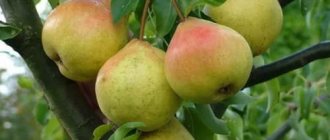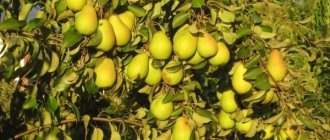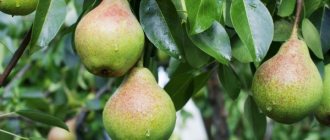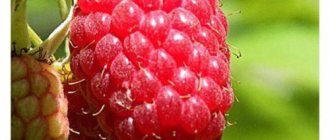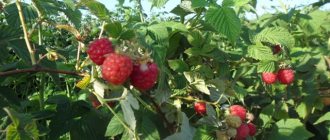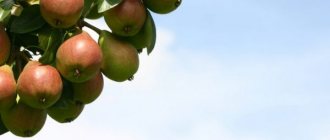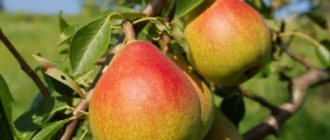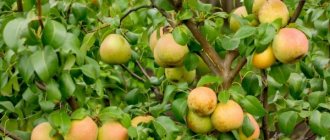Gardening » Pear
0
903
Article rating
Kira Stoletova
Kieffer pear is a hybrid variety from the USA. Belongs to fruits of the autumn ripening category. The myth says that the variety was bred by accident in 1864 from the seed of a Chinese pear pollinated with pollen. The author of the variety is the famous gardener Peter Kieffer. The variety does not lose popularity even after 150 years, which proves its reliability.
Characteristics of the Kieffer pear variety
Description of the variety
Kieffer pear is a medium-sized variety with rapid growth. The tree has a fairly dense crown in the shape of a pyramid. The gray bark of the trunk becomes covered with cracks over time. Skeletal branches grow at an angle of 25-350 and are painted in dark gray tones.
Smooth shoots grow quite thick with pubescence in the upper part. The buds are small in size and grow in a sharp-conical shape. The leaves are large, ovoid in shape with jagged ends. In summer they have a rich green tint, and by autumn they turn purple. The platinum of the sheet is glossy and leathery.
Flowering of this variety begins early. The fruits are of average size (150-200 g), less often they grow to large sizes (350-400 g). As for the shape, the fruits can be either standard pear-shaped or barrel-shaped. The peel resembles a quince because it is thick, rough and lumpy.
During harvest, the fruits are colored light green, but in the process of full ripening they change to yellow, at the same time becoming covered with brown spots. The white flesh of the pear is juicy and crisp with a sweet-tart taste and a noticeable aftertaste.
Taste qualities
The fruits ripen by the second half of September. Moreover, ripe pears are held well on the branches and falling off is not typical for them. The fruits remain for another 2-3 weeks until they are fully ripe. Taste and presentation are preserved until the beginning of winter.
The pulp of the ripe fruit has a white tint with yellowness and a pleasant aroma. The taste of the pear is quite sweet with a slight tart taste. Juicy and crispy fruits can be consumed both fresh and canned.
Productivity
When planting a seedling, you should know that the first harvest can be obtained no earlier than in 5-6 years. Starting from this age, the young tree will annually delight with a large number of fruits. At the age of 15-17 years you can get 18-20 tons per hectare, and from 23 years this value will increase to 26 tons.
Advice! Proper care and compliance with certain agricultural practices will allow you to get up to 300 kg from one tree.
Features of planting a pear tree
The first difficulty that a gardener will encounter when choosing a Kieffer seedling for planting is the lack of quality seedlings. To avoid making a mistake when making a purchase, contact a specialized nursery.
If fruit tree seedlings are recommended to be purchased and planted at the age of two, then for the Kieffer seedlings the best survival rate is noted at the age of one. The more nitrogen fertilizers used to force the tree, the lower its frost resistance will be.
If the purchased seedling has branches, its height should not exceed 60 cm, and the length of side shoots 10 cm. An unbranched seedling has a height of up to 120 cm, the trunk thickness is 1 cm. Make sure there is no damage to the bark and roots. The branches of a healthy plant are flexible, elastic, and the buds are alive.
When making a purchase, remember the zoning. Planting a Kieffer pear in the Moscow region will result in the death of the plant. Since the tree does not tolerate transplantation well, determine a permanent place for it.
Planting technology:
- prepare a hole 1 m deep and 80-100 cm in diameter;
- mix the top fertile layer of soil removed during digging with two buckets of mature compost or humus;
- pour the resulting soil mixture into the bottom of the hole in the form of a mound;
- dip the roots of the seedling into a clay mash, spread evenly over the surface of the embankment;
- add the required amount of soil without deepening the root collar, compact the soil, water generously;
- mulch the tree trunk circle with peat chips.
Before planting, do not forget about the presence of pollinators for Kieffer. Choose sunny areas protected from cold winds.
Features of care
One of the advantages of the Kieffer variety is its unpretentiousness. Moistening the soil for proper growth and development of the tree should be done 3 times during the summer: during the swelling of the buds, the growth of buds and the appearance of ovaries.
It is recommended to prune branches in the first 5 years to form the correct skeleton. In this case, the upper parts of the conductor must be removed to create several tiers. Bearing branches should be bent and fixed to artificially increase the growth angle. This procedure is necessary so that they do not break under the weight of a bountiful harvest.
Important! Dry and damaged branches must be pruned annually.
Fertilizers, like watering, are done three times per season:
- In the spring months, organic matter and nitrogen fertilizers are applied;
- In the second half of summer, potassium-phosphorus compounds are used;
- During the autumn digging of the soil, wood ash is added.
The Kieffer variety is quite resistant to diseases and pests, but you should not test this. To prevent infection before and after flowering, it is recommended to treat it with fungicides. When the fruits are fully formed, you should organize feeding with a saline solution, which will repel annoying wasps.
Since it is recommended to grow this variety in areas with a temperate climate, the tree will not require special shelter for the winter. It is enough to lightly dig up the area near the trunk, add mulch and cover the lower part of the trunk with spruce branches.
Care
The tree needs good care
The Kieffer pear variety needs careful care, which includes:
- feeding;
- mulching;
- watering;
- pruning and crown formation.
Following the rules of care allows you to get a generous and high-quality harvest.
Top dressing
In autumn, all fruit-bearing plant varieties need more minerals. At any garden center you can purchase a mineral complex for fruit crops. In the spring, the seedling needs nitrogen fertilizers. The best are ammonium nitrate and urea.
Once every five years you need to feed the tree with potassium, phosphates and lime. Feed with nitrogen fertilizers annually before flowering. At the end of summer, if desired, you can feed the tree with a solution of phosphorus and potassium, but not more than 150 ml.
Mulching
If a tree is planted on depleted land, mulching will undoubtedly help, keeping the soil fluffy, enriching it with useful substances and helping to defeat weeds.
Place mulch on warm soil and chop thoroughly before laying. If the layer survives the winter, remove it to allow the soil to warm up. Most often, bark, sawdust, pine needles and cones are used as mulch.
Watering
Typically watering occurs 3 times a season. You need to pay attention to weather conditions; in case of drought, about 7 buckets of water may be required. At the end of autumn, dig a small hole around and fill it with water, so the root system will be provided with moisture. It is advisable to repeat the procedure three times.
To prevent water from spilling, make small borders around the hole. Before watering, take some soil and squeeze it to test the condition. If humidity is high, reduce the number of buckets to 5.
Avoid the most common mistake - watering near the trunk. The tree should be watered under the canopy.
Crown trimming
The tree needs pruning; it needs to be multi-tiered by 4 years. To do this, you need to cut the conductor. You also need to remove and bend the side shoots to avoid thickening of the crown. It is advisable to carry out circumcision before sap flow. It is advised to remove infected or rotten fruits.
In summer and winter it is better not to prune. Weather conditions during these seasons will not allow the cutting site to linger, which will significantly weaken the plant.
First, you need to trim off diseased, broken branches. In the next period, pruning is needed in order to prolong fruiting; for this you need to cut out some of the unnecessary skeletal branches. You need to pay attention to diseased branches and prune them as soon as they appear.
Pollination methods
The variety is self-pollinating, so fruits can be expected from the growth of one tree. However, experienced gardeners recommend planting other pollinating trees in close proximity to obtain a rich harvest.
Pears of one variety, Kieffer, are not the best option for cross-pollination; for this reason, other strains are planted.
Important! Organizing cross-pollination will increase the yield both on Kieffer and on the pollinator tree itself.
The best pollinating varieties are the following:
- Saint Germain;
- Conference;
- Bon Louise.
Pests and diseases
The description of the Kieffer pear indicates good immunity to diseases, but this does not mean the variety does not need care. It is recommended to treat the pear with a salt mixture, since wasps do not allow the fruit to retain nutrients, as a result of which the fruit will rot. It is imperative to treat the crown with Fufafon to prevent worms from appearing. To protect the plant from scab and spoilage of pears, you need to regularly pick damaged fruits from the branches. It is important to regularly clear the soil around the trunk of weeds in order to avoid the proliferation of gypsy moths.
Advantages and disadvantages of the variety
Gardeners who grow Kieffer pears note the following advantages of the variety:
- Resistance to many viral and bacterial diseases, including fire blight;
- Easy to care for;
- Possibility of growing on different types of soil;
- Annually receiving a rich harvest;
- High taste qualities;
- Marketable condition;
- Good transportability;
- Drought tolerance.
Despite the large number of advantages, the variety also has disadvantages, which include poor frost resistance and an unusual aftertaste.
Reviews from gardeners
Valery, 35 years old, Ryazan
I have been growing the Kieffer pear variety for 10 years. The taste is average, the tree constantly freezes. The variety is southern and does not tolerate our conditions well. I use it for grafting and holding cuttings.
Raisa, 57 years old, Stavropol
Kieffer is a good late-ripening variety. I grow it for a fall harvest. The fruits are stored until December and are suitable for making compotes. It is inferior in taste to many other varieties, but goes well in home preparations.
Mikhail, 46 years old, Rostov-on-Don
I identified the Kieffer pear variety from photos and descriptions on the Internet. The tree has been growing with its parents for more than 12 years. The variety is undemanding to growing conditions and bears a lot of fruit. Even in lean years, you can count on a good harvest. Disease resistance is high; the Kieffer variety is practically disease-free.
Reviews
Ivan, 37 years old. Krasnodar
I have planted 5 trees of this variety on my site, and I don’t intend to stop there. From one tree you can get 150-200 kg of tasty and aromatic fruits, which sell like crazy on the market!
Svetlana, 45. Alushta
In the garden, in addition to the Kieffer pear, I grow several varieties of grapes, dogwoods and a lot of peaches. However, it is the pear that attracts the eyes of my guests. On the spreading branches, a huge number of large fruits ripen until the velvet season. Many vacationers like their unusual taste.
Planting a pear
The Kieffer variety is planted in a prepared place. Healthy seedlings are selected for planting. According to the description, photos and reviews, the Kieffer pear is undemanding in terms of soil quality, but requires constant sunlight.
Preparing the site
Planting work is carried out in early spring before the beginning of the growing season. Autumn planting is allowed at the end of September, when sap flow in the plants slows down. Trees planted in the fall take root best.
For the Kieffer variety, choose a place located on the south or southwest side of the site. The place should be constantly illuminated by the sun, located on a hill or slope.
Important! Pear prefers chernozem or forest loamy soils.
Poor, clay and sandy soil is not suitable for planting. Groundwater must be deep, since the root system of the pear grows to 6-8 m. Constant exposure to moisture negatively affects the development of the tree.
The soil for the Kieffer variety is fertilized with compost, humus or rotted manure. One pit requires up to 3 buckets of organic matter, which is mixed with soil.
The addition of coarse river sand helps improve the quality of clay soil. If the soil is sandy, then it is fertilized with peat. Of the mineral fertilizers when planting Kieffer pears, you will need 0.3 kg of superphosphate and 0.1 kg of potassium sulfate.
The Kieffer variety needs a pollinator. At a distance of 3 m from the tree, at least one more pear is planted for pollination: the Saint-Germain or Bon-Louise variety.
Work order
Healthy two-year-old Kieffer pear seedlings are selected for planting. Healthy trees have a developed root system without dry or rotten areas, and the trunk is elastic without damage. Before planting, the roots of the Kieffer pear are immersed in water for 12 hours to restore elasticity.
Procedure for planting pears:
- Preparing the planting hole 3-4 weeks before transferring the seedling to a permanent place. The average size of the hole is 70x70 cm, depth 1 cm. The root system of the tree must fit completely into it.
- Application of organic and mineral fertilizers to the top soil layer.
- Part of the resulting soil mixture is placed at the bottom of the hole and compacted thoroughly.
- The remaining soil is poured into the hole to form a small hill.
- The roots of the seedling are dipped into clay diluted with water.
- A peg is driven into the hole so that it rises 1 m above the ground.
- The Kieffer pear seedling is placed in a hole, its roots are straightened and covered with soil.
- The soil is compacted and watered abundantly using 2-3 buckets of water.
- The tree is tied to a support.
Young plants need frequent watering. In cold winters they are covered with agrofibre to protect them from freezing.
History of the cultivar
The variety received its name in honor of the American breeder Peter Kieffer, who grew the seedling by sowing seeds of the Ussuri or sandy (Chinese) pear. The tree was randomly pollinated, presumably with pollen from Williams or Bere Anjou. Kieffer's seedlings were recognized as a new hybrid in 1863.
From Philadelphia, the seedlings came to Russia, where they immediately fell in love with gardeners from the southern regions. Since 1947, after testing, the cultivar was allowed to be grown in the North Caucasus region, but it is also found in Central Asia, Ukraine, Georgia, and Moldova.
Reviews about this variety
Reviews from gardeners force them to choose Kieffer pears for the garden. They tolerate all diseases well and are very popular in the southern regions. You can find such a pear in the Krasnodar Territory, Rostov and many other regions.
Gardeners are pleased that the tree has a huge yield. Even when other trees cannot give you a harvest, this variety will save you.
However, remember that it makes no sense to plant this variety in winter climates. He does not tolerate the cold very well.
Kieffer pear – reviews and description of the variety, planting and care with photos
The Kieffer pear variety was obtained in Philadelphia back in 1863. It is distinguished by good taste and presentation of the fruit. Read about the properties of the variety and agricultural technology for its cultivation in the article.
Botanical description of the variety
The variety was bred in the USA in 1863. Peter Kieffer, after whom it is named, is a plant breeder and researcher. He obtained a new variety by accidentally pollinating an Ussuri pear with pollen from the Bere Anzhu variety (according to one version). It was included in the State Register of the USSR in 1947.
Kieffer can be grown in the Central Black Earth, as well as the North Caucasus region. In addition, it is grown in Ukraine, the Baltic states, Moldova and other European countries. Kieffer has many synonymous names. Among them are Japanese pear, Chinese pear, Kieffer seedling, Kieffer hybrid.
The tree is a representative of medium-sized varieties. Characterized by high growth vigor, endurance, resistance to heat and cold. It is also considered undemanding to growing conditions and rarely gets sick. Characteristics of the variety:
- early ripening, self-sterile, requiring an additional pollinator tree;
- fast-growing, medium-sized tree;
- crown pyramidal, dense;
- shoots are thick, long, straight, dark gray, extend from the trunk at an angle of 45 degrees, there is pubescence in the upper part of the shoots;
- foliage is average;
- leaves are large, ovoid with burgundy petioles;
- fruits are about 120–150 g (average), but can reach 200–300 g;
- the shape of the pears is barrel-shaped;
- the peel is lumpy, slightly ribbed at the apex, rough;
- the color of the peel is bright yellow with rusty spots, at technical maturity it is light green; if it grows on the sunny side, then a brown blush is possible on pears;
- The pulp is white with a yellowish tint, tastes sweet with slight sourness, juicy, dense, medium aroma.
To get a harvest, do not forget to plant another tree nearby, since Kieffer is not self-pollinating. It is recommended to pollinate it with Bon Louise or Saint Germain varieties.
The fruits are perfect for fresh consumption, as well as for making jellies, jams and other homemade preparations. The yield of the variety is 180–250 c/ha. The tree grows up to 50 years. As it grows, its yield changes as its crown size increases, so individual trees can produce a yield of over 300 kg. The fruits ripen at the end of September.
Plant characteristics
According to its characteristics, Kieffer is a heat-loving variety, so it cannot tolerate cold temperatures below -10°C. The pear does not recover very quickly after freezing either. Among diseases, the variety is resistant to scab and fire blight.
- Advantages of the variety:
- early ripeness;
- high productivity;
- excellent presentation of the fruit;
- the possibility of using for breeding new varieties as a carrier of resistance to fungal diseases;
- disease resistance;
- loyalty to any type of soil;
- good drought resistance.
- The disadvantages include:
- poor frost resistance;
- low ability to recover after frost;
- average taste - tart taste; some believe that the fruit has a turpentine taste.
Can be grown in any type of soil, although loam is preferable. Loves sunny areas and tolerates heat and drought well.
Features of planting a pear
If you are going to plant a pear, then you should keep in mind a few basic rules:
- Kieffer needs a pollinator plant, so you will have to plant 2 different pears. Buy one of the above varieties or ask the seller whether the variety he offers will pollinate your pear.
- Prepare holes for each tree up to 1 m wide and deep. Please note that pear trees reach a height of 12 m and a crown diameter of 5 m, so you must consider whether it will be comfortable for the tree when it grows.
- Pears love the sun, and the Kieffer variety especially. He will need an area where the sun shines for at least 8 hours a day.
- The soil can be anything. But pear roots should not be constantly in water, so avoid wetlands. The soil should also be permeable to air, which means it should be loamy or sandy. The desired soil acidity level is 6.5 pH.
Selection of planting material
As a rule, we buy seedlings for planting in nurseries or from private individuals in markets, so it is important to know what to look for when purchasing:
- the root system must be powerful, the more developed it is, the more growth force the tree will have;
- Kieffer needs a companion for pollination, so the other pear variety purchased must coincide in flowering period with the main tree;
- The wood of the trunk should be young, shiny, without signs of damage by pests or diseases.
- The height of the seedling can be from 0.5 m to 1.0 m.
Step-by-step planting technology
Before planting, pear roots are soaked in water for several hours. This will help them straighten out. Do not plant on a cold or rainy day to avoid damaging the root system.
The main point of planting is maintaining the interval between plants. So, there should be at least 5 m between neighboring pears, taking into account that the crown will occupy about 7 m in diameter. It is important not to plant them too close so as not to create favorable conditions for pests and infections, but not too far away so that they can pollinate each other. Planting technology:
- Dig a hole 1 x 1 m.
- Place a layer of rotted manure (1 bucket) at the bottom of the hole.
- Cover this layer with soil, which was the topmost layer when digging the hole.
- Place the seedling in the center.
- Fill in the remaining soil.
- Water.
- Compact the soil around the trunk.
When filling the hole with soil, leave a small edge. It will limit the flow of water from the hole during watering.
Important! Water should not stagnate at the roots. This leads to their rotting and death of the tree!
Description of the hybrid
Let's take a closer look at the description of the Kieffer variety.
Tree
The Kieffer pear is characterized by trees with a rapid growth rate. The seedlings form a medium-sized tree 3-5 m high with fissured gray bark on the trunk. The crown is pyramidal and prone to thickening.
Density is ensured by a large amount of foliage and shoot growth at an acute angle (30 degrees). Due to such a close location of the branches in relation to the conductor, constant monitoring of the condition of the crown is required.
The main branches that make up the skeleton are colored dark gray. Side shoots grow straight, are characterized by medium thickness, a smooth surface with a small edge on the tops. The annual growth is greenish-brown with a purplish tint. The pointed buds are pressed tightly to the branches. Fruiting on perennial wood, complex ringlets (fruits).
The variety is valued for its quality and decorativeness. The foliage is large, dark green in color with a dense glossy surface. The shape of the plate is oval with a pointed tip and a serrated edge, curved upward. The leaves sit on short burgundy petioles, and in the fall the tree dresses up in a crimson caftan. It blooms very early and requires additional pollinators. Saint Germain and Bon Louise are perfect for this role.
Fruit
The Kieffer variety belongs to the autumn group. Below are the characteristics of the fruit:
- medium-sized pears from 120 to 180 g. Large specimens reach 300-400 g;
- the shape of the fruit resembles a quince - barrel-shaped or cube-shaped with a bumpy surface;
- the skin is thick, dry to the touch. The surface roughness is caused by the accumulation of a large number of large rusty subcutaneous freckles;
- at the stage of removable maturity, the main color is light green, after harvesting and two weeks of ripening it changes to a uniform golden-yellow hue with a faint reddish-brown blush on the illuminated side;
- the fruits are attached to the branches with strong stalks thickened on both sides;
- When cut, rough yellowish-white pulp with a large amount of juice is observed. The density is average, there are granulations around the core, giving the fruit roughness;
- taste qualities were rated 3.7 points due to strong astringency and turpentine aftertaste. Sugar content 8.1%;
- since many people call the taste of fruits mediocre, the fruits are more often used for canning;
- ripening by the third ten days of September, shelf life 60-70 days, high transportability.
Useful properties of the variety
When you have such a wonderful variety in your garden, you will definitely be healthy. Juicy fruits have a huge number of useful components: a sea of vitamins, fructose, citric, malic acid, iron, calcium, copper and much more.
Kieffer pears strengthen the immune system and are excellent against colds. They have an anti-inflammatory and antitussive effect. Thanks to such fruits, the intestines, kidneys, liver and other organs function well. Decoctions from pears are excellent for removing toxins and have a calming effect: they will help get rid of stress, tension, and simply improve your mood. Nutritionists advise eating pears if you are overweight. But for athletes this is a godsend: this fruit relieves tension in the muscles.
When choosing such a specific variety, be sure to familiarize yourself with its characteristics. If everything suits you, you will be able to enjoy a large harvest of juicy, unusual, and most importantly healthy fruits.
